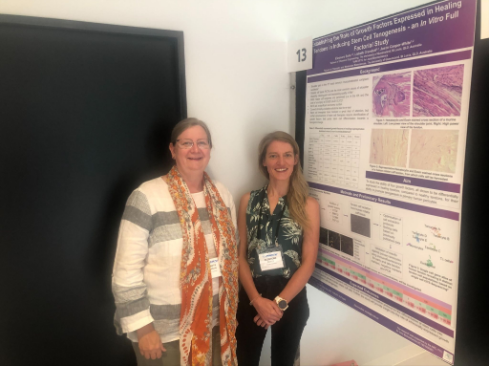Members of the ITTC for Joint Biomechanics team had the exciting opportunity of presenting their work at the 27th Annual Conference Australasian Society for Biomaterials and Tissue Engineering held in Melbourne from Wednesday the 20th of April to Friday the 22nd of April.
Dr Eleonore Bolle presented her work on the ‘Establishment of an in vitro skin model to study bacterial infection around percutaneous devices’ as part of her work under Program 3 at the centre. Program 3 is dedicated to the multiscale computational models and simulation outputs and detailed characterisation and mapping of shoulder joint biomechanics to inform the design, development, optimisation, and validation of engineered scaffolds for rotator cuff repair.
Her talk brought insight to the use of percutaneous devices that are used to connect internal organs to external medical devices such as prosthesis, catheters and electrical drivelines in clinical practice. Such devices breach the skin’s natural barrier and thus create an entry point for pathogens, with the aim of her research to design novel implant surfaces that can better integrate with the skin to reduce bacterial infection, implant rejection, and ultimately improve patient healing quality and recovery times.
In her study of the same name published in the ‘Frontiers of Microbiology’; on 14 May 2020, Dr Bolle outlined her formative work on this topic where in vitro studies of Staphylococcus aureus, the most common cause of driveline-related infections, were used to infect mock drivelines of melt electrowriting (MEW) with smooth or porous un-seeded and porous pre-seeded with human fibroblasts, implanted with human skin grafts. She successfully demonstrated that infection largely occurs in micro-gaps caused by insufficient skin integration between the scaffold and the surrounding skin, which validated clinical reports of driveline infection pathways.
Dr Bolle additionally presented her poster on ‘Establishing the Role of Growth Factors Expressed in Healing Tendons in Inducting Stem Cell Tenogenesis,’ which highlighted her work over at the University of Queensland on developing tissue scaffolds.
On the last day of the conference our affiliate researcher, Dr Edmund Pickering, engaged the audience with his talk on ‘MEW tubular scaffolds with massively tailorable mechanical behaviour.’ Dr Pickering explained how MEW is currently being used to create tissue scaffolds and how their successful biological integration into patients comes down to their mechanical abilities and ability to match native tissue properties, whilst simultaneously supporting cell attachment and proliferation.
Dr Pickering’s talk highlighted the geometric properties of tubular crosshatch scaffolds using Finite Element (FE) modelling and demonstrated that mechanical behaviour is largely tunable through control of basic scaffold parameters of pore area and angle as tested under tension, compression, bending, and radial loading. His work is a huge step towards defining optimal scaffold design, particularly to assist us with our aims under program 3 to design patient scaffolds for rotator cuff tears.
With many emerging technologies and advancements in the field of tissue engineering, the team was absolutely delighted to share their findings thus far and to promote the centre’s research.
We thank the conference organisers for a warm welcome and look forward to the next conference in 2023.
References:
Bolle ECL, Verderosa AD, Dhouib R, Parker TJ, Fraser JF, Dargaville TR, Totsika M. (2020). An in vitro Reconstructed Human Skin Equivalent Model to Study the Role of Skin Integration Around Percutaneous Devices Against Bacterial Infection. Frontiers in Microbiology, 11 (670). doi: 10.3389/fmicb.2020.00670. PMID: 32477277; PMCID: PMC7240036.
Pickering, E., Paxton, N. C., Bo, A., O’Connell, B., King, M., & Woodruff, M. A. (2022). 3D printed tubular scaffolds with massively tailorable mechanical behavior. Advanced Engineering Materials, 24(11) doi:10.1002/adem.202200479

